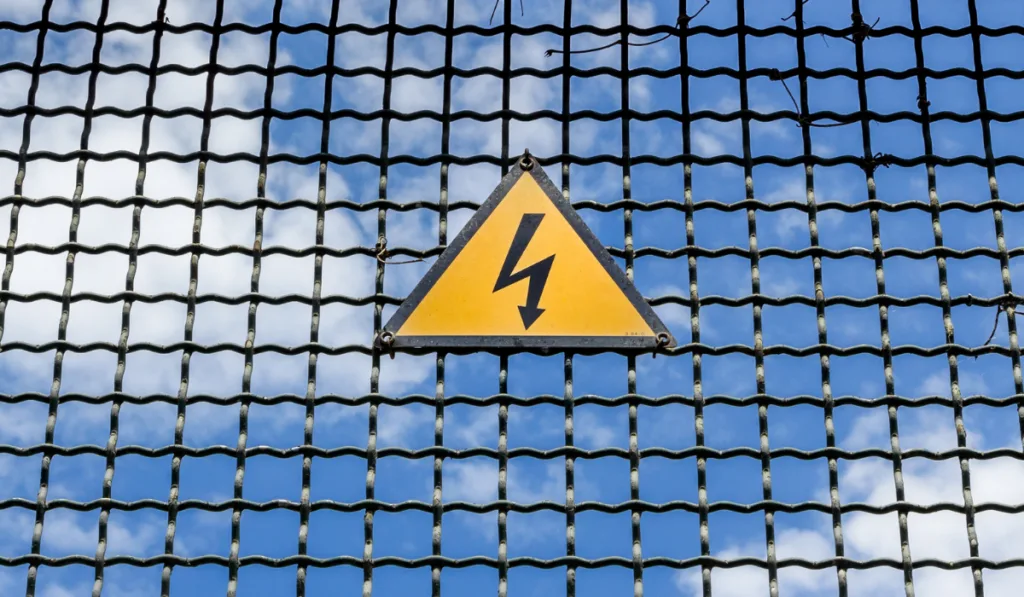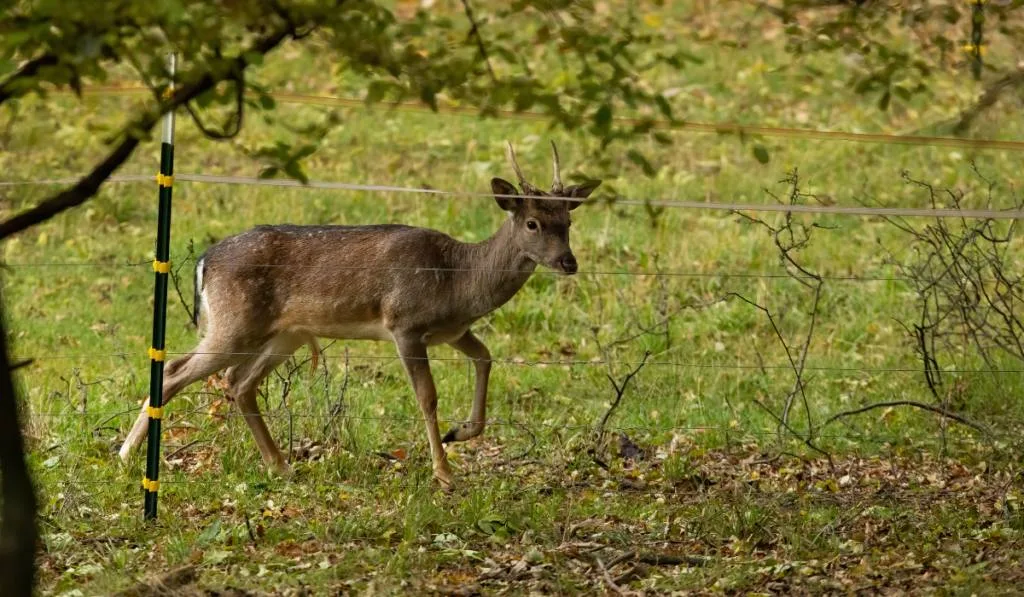An electric fence is a good way to keep your cattle in one place and to stop them from wandering around your farm or homestead. A fence will keep your animals in and, hopefully, predators out! There are many ways to construct a good fence according to your needs and requirements.
To build an electric fence for cattle requires some basic components, including an energizer, wire, fence posts, and accessories to attach the wire to the posts. You will also need an electrical source which can be mains power or battery. The construction of the fence could be permanent or temporary.
Building a cattle fence can take some time, but as long as you do your research and planning first, you should be able to construct the fence that you need for your farm.

Deciding on what type of fence that you need and what materials to use for the job is determined by the livestock that you are raising on your farm. In this article, we discuss how to build an electric fence for cattle.
Table of Contents
How To Construct An Electric Fence For Cattle
An electric fence for keeping and controlling your cattle’s movements is an effective tool on any farm. There are different types of fencing that you can erect on your farm for different uses.
Fencing for cattle needs to be sturdy as these animals, especially beef cattle, are big and strong enough to push through any fence.
A dairy cow is a bit smaller, so it does not require a fence as strong as a beef cow, but they have been known to use a fence post as a scratching post, thereby knocking it over and destroying the fence!
An alternative to buying expensive equipment for building and maintaining sturdy fences is to construct an electric fence. The attraction of this type of fence is that the cattle can be trained to keep away from the fence or receive a shock!
The psychology is to train the cattle to stay away from the fence or get zapped! Training them in this way will reduce your costs as you will not have to keep replacing the fence every time a wayward cow walks over the wire and breaks the fence down!
What Equipment Do I Need For An Electric Fence?
Before building the fence, find out the legal requirements for fencing in your area to see if you can erect an electric fence and if you can use barbed wire.
Once you have found out all the legal requirements, it’s time to start building but make sure you buy all your supplies from a reputable supplier!
For a permanent electric fence, you will need:
Wire, Posts, And Gates For An Electric Cattle Fence
Decide how many wires are going to be on the fence – one, two, or five. The bottom wire should be 22 inches (55cm) from the ground and the top wire 49 inches (125cm). If you plan on keeping bulls, the fence could be up to 40 inches (152cm) high.
The wire should be high tensile 12 ½ gauge galvanized high wire. Purchase the correct length for the area that you will be enclosing and for stands that you are going to use.
Posts need to be planted deep. At least half of the full length of the post should be planted underground. Ideally, the posts should be spaced every 80 to 100 feet (24 – 30 meters).
Use a good quality gate. Be sure to measure the size of the opening before buying the gate. An underground coated cable is required to transfer power from one side of the gate to the other.

Electrical Equipment For An Electric Cattle Fence
The equipment you buy should be sturdy enough to use outdoors, so be sure to use the correct type of equipment, or you will be replacing it often.
- Energizer. We recommend that you buy a bigger energizer than what you currently need to ensure that enough voltage will flow through the wire even if it is touched by wet grass and for future expansion. The requirements are 2000 volts in the summertime and 4000 volts in the winter.
- Ground rods. You will need a minimum of 3, 6– 8 foot (1.8 – 2.4 meter) long rods.
- Insulators. 1 x insulator is required per wire per post. Nails are needed to secure the insulators on the posts.
- Corner strainers. 1 x corner strainer per wire per corner post is a requirement.
Top Tips:
- Install the energizer out of reach of rodents who will chew through the wires!
- Always use galvanized materials as they will not rust!
- Install a lightning rod!
How To Construct Your Electric Cattle Fence
Your fence can be erected as a permanent or a portable structure, so choose your location carefully and construct according to your plans.
- Clear the area for the posts and the fence. Make sure that the fence line is clear from any debris that could interrupt the electric charge.
- Install the posts. Use a hole digger to dig holes deep enough for your posts for a permanent fence, or use small metal or plastic push-in posts for a temporary fence.
- Install the gate. Transfer the power under the gate from one side to the other using an under gate cable.
- Attach the wires to the post. Attach the high tensile wires using the insulators and secure them to each post using nails. Start feeding the wires through the insulators at a corner post. Don’t pull the wire too tight when installing. Remember to wire the gate correctly.
- Connect the wires. Every second wire should be connected to the energizer, with the remaining wires left alone as grounding wires.
- Install the ground rods and additional earth stakes. Connect the top of each stake with a lead-out cable.
- Check the voltage on your fence. Test at the furthest end from the energizer to get an accurate measurement of the voltage. It should have a minimum of 3000 volts running through the wires.

Will An Electric Fence Harm My Cattle?
A short zap of electricity from an electric fence will not harm your cattle. It will hurt for a moment, and the memory will last, hopefully, long enough to dissuade them from returning to the fence and trying to get out!
The aim of the electric fence is to train cattle to keep away from the fence by giving the animal a shock if it tries to cross the fence.
The cows can be trained to not even approach the fence at all, thereby giving you peace of mind from knowing where your cattle are at all times and saving you money on repairs to fencing.
Can I Power My Electric Fence With Solar?
Solar is a great option for farms in remote areas that are not connected to the power grid or simply for homesteaders who are living off-grid.
By using a solar-powered energizer, you can be sure that your animals are protected and contained during blackouts and power outages.
Many electric fence kits come with a solar power option. If this is an option for you, ensure that you buy the correct kit with the right amount of voltage for your size area.
Bear in mind that there may be an additional cost for going the solar power route, but solar power benefits far outweigh the disadvantages!
When installing the solar panel, make sure that it is facing the sun at high noon to maximize the rate of converting sunlight into energy.
Conclusion
An electric fence is an efficient solution for any size farm as they require far less maintenance than other types of livestock fencing. With minor maintenance, a quality electric fence can last for around 40 years or more.
The posts may need to be replaced, and the wire may get damaged from cattle running into it, but an electric fence is still an affordable method of keeping your cattle safe and in one place.
Always make sure to buy the best equipment that you can afford from a reputable dealer. Speak to other farmers in your area who have already installed electric fences to see what experiences they have had before deciding what to buy for your farm’s needs.
Resources
- https://www.doityourself.com/stry/building-an-electric-fence-for-cattle
- https://www.wikihow.com/Make-an-Electric-Fence
- https://www.outdoorhappens.com/best-fence-for-cattle/
- https://www.grass-fed-solutions.com/livestock-fencing.html
- https://onpasture.com/2019/05/06/teaching-livestock-to-respect-electric-fences/
